2010 FORD FUSION HYBRID battery
[x] Cancel search: batteryPage 3 of 329
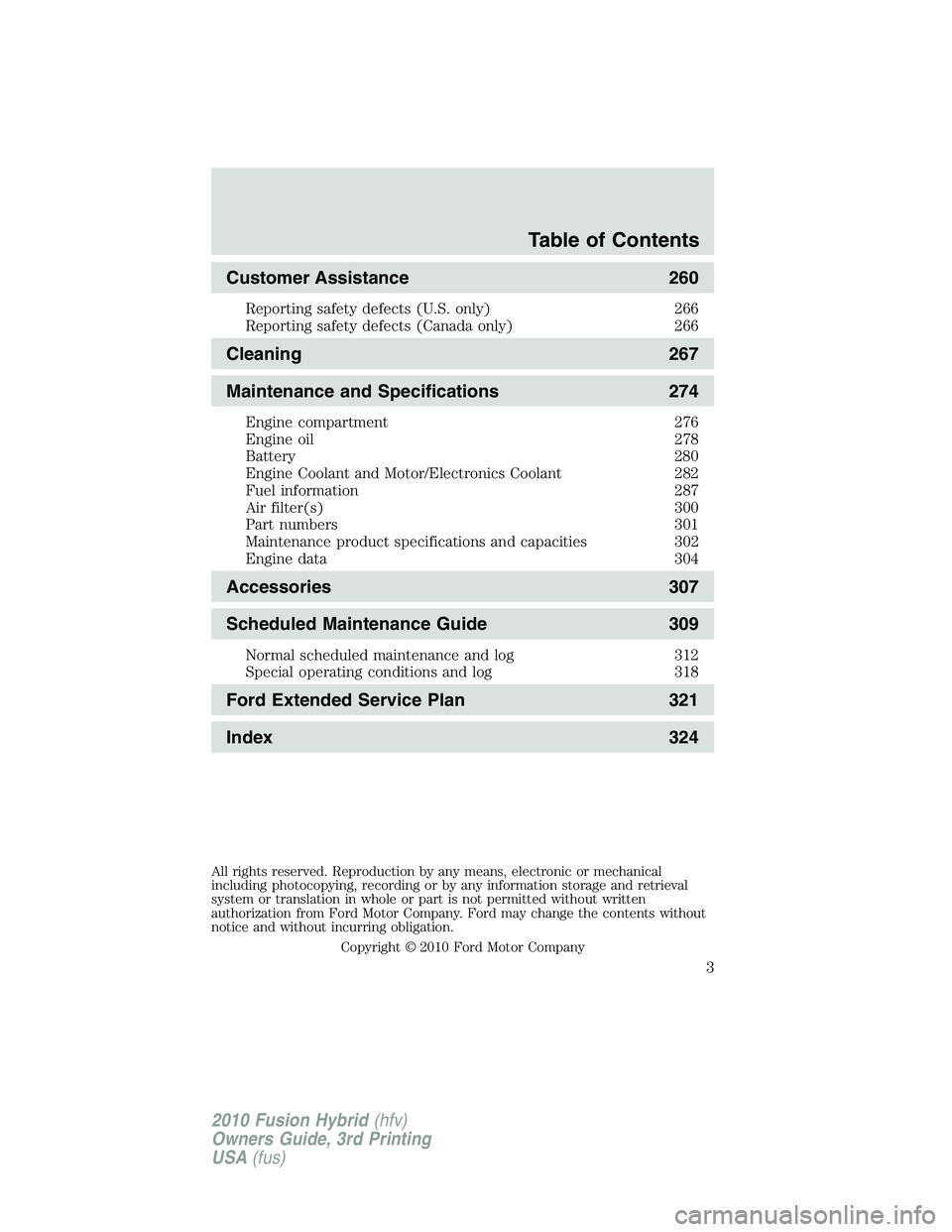
Customer Assistance 260
Reporting safety defects (U.S. only) 266
Reporting safety defects (Canada only) 266
Cleaning 267
Maintenance and Specifications 274
Engine compartment 276
Engine oil 278
Battery 280
Engine Coolant and Motor/Electronics Coolant 282
Fuel information 287
Air filter(s) 300
Part numbers 301
Maintenance product specifications and capacities 302
Engine data 304
Accessories 307
Scheduled Maintenance Guide 309
Normal scheduled maintenance and log 312
Special operating conditions and log 318
Ford Extended Service Plan 321
Index 324
All rights reserved. Reproduction by any means, electronic or mechanical
including photocopying, recording or by any information storage and retrieval
system or translation in whole or part is not permitted without written
authorization from Ford Motor Company. Ford may change the contents without
notice and without incurring obligation.
Copyright © 2010 Ford Motor Company
Table of Contents
3
2010 Fusion Hybrid(hfv)
Owners Guide, 3rd Printing
USA(fus)
Page 6 of 329
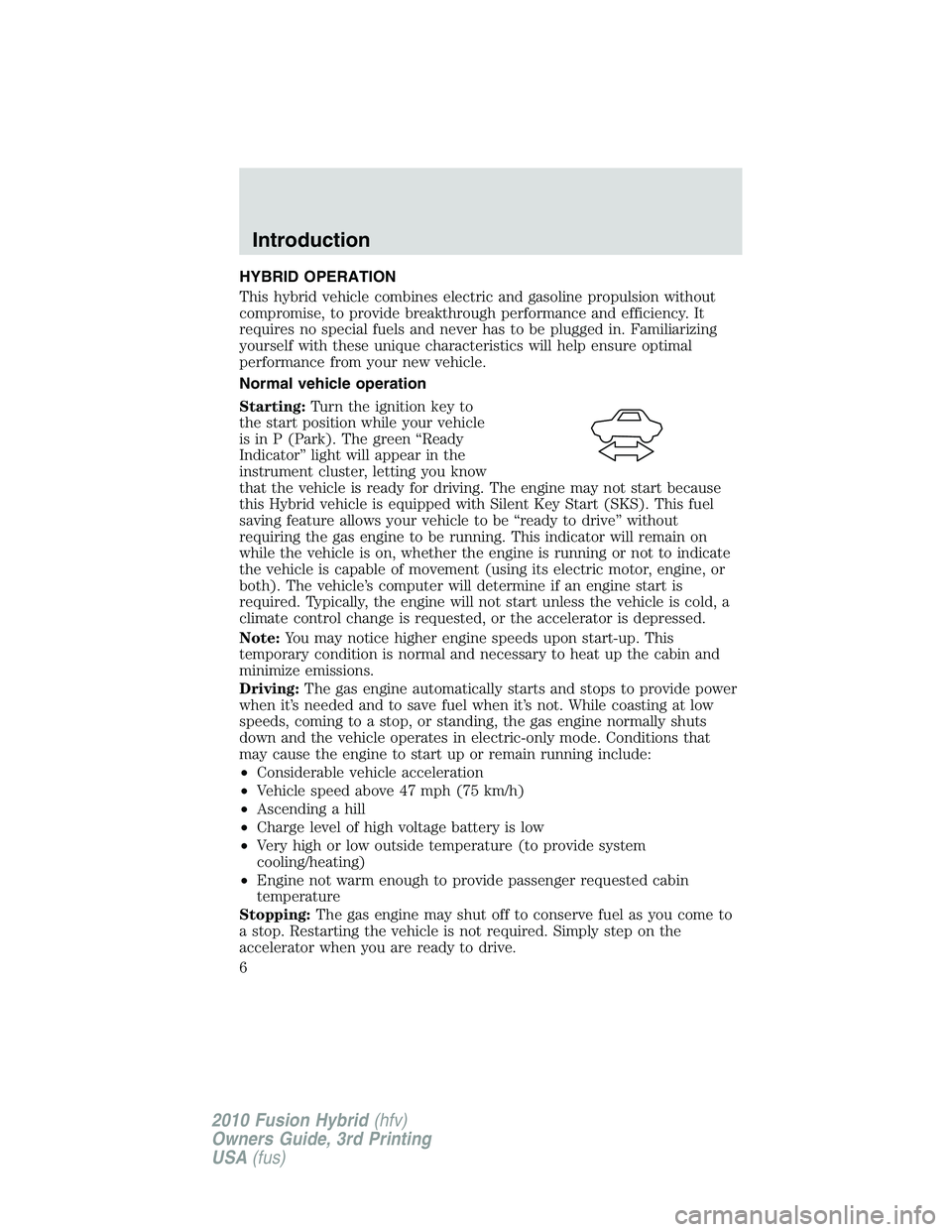
HYBRID OPERATION
This hybrid vehicle combines electric and gasoline propulsion without
compromise, to provide breakthrough performance and efficiency. It
requires no special fuels and never has to be plugged in. Familiarizing
yourself with these unique characteristics will help ensure optimal
performance from your new vehicle.
Normal vehicle operation
Starting:Turn the ignition key to
the start position while your vehicle
is in P (Park). The green “Ready
Indicator” light will appear in the
instrument cluster, letting you know
that the vehicle is ready for driving. The engine may not start because
this Hybrid vehicle is equipped with Silent Key Start (SKS). This fuel
saving feature allows your vehicle to be “ready to drive” without
requiring the gas engine to be running. This indicator will remain on
while the vehicle is on, whether the engine is running or not to indicate
the vehicle is capable of movement (using its electric motor, engine, or
both). The vehicle’s computer will determine if an engine start is
required. Typically, the engine will not start unless the vehicle is cold, a
climate control change is requested, or the accelerator is depressed.
Note:You may notice higher engine speeds upon start-up. This
temporary condition is normal and necessary to heat up the cabin and
minimize emissions.
Driving:The gas engine automatically starts and stops to provide power
when it’s needed and to save fuel when it’s not. While coasting at low
speeds, coming to a stop, or standing, the gas engine normally shuts
down and the vehicle operates in electric-only mode. Conditions that
may cause the engine to start up or remain running include:
•Considerable vehicle acceleration
•Vehicle speed above 47 mph (75 km/h)
•Ascending a hill
•Charge level of high voltage battery is low
•Very high or low outside temperature (to provide system
cooling/heating)
•Engine not warm enough to provide passenger requested cabin
temperature
Stopping:The gas engine may shut off to conserve fuel as you come to
a stop. Restarting the vehicle is not required. Simply step on the
accelerator when you are ready to drive.
Introduction
6
2010 Fusion Hybrid(hfv)
Owners Guide, 3rd Printing
USA(fus)
Page 7 of 329

Transmission Operation:Due to the technologically advanced,
electronically-controlled Continuously Variable Transaxle (eCVT) you will
not feel shift changes like those of a non-hybrid vehicle. Your hybrid’s
transmission is designed to do its work seamlessly.
Since engine speed is controlled by the transmission, it may seem
elevated at times. This is normal hybrid operation and helps
deliver fuel efficiency and performance.
Neutral:It is not recommended to idle the vehicle in N (Neutral) for
extended periods of time because this will discharge your high voltage
battery and decrease fuel economy. Because of the unique nature of the
hybrid vehicle, the engine will not start in the N (Neutral) position. Also,
the engine cannot provide power to the hybrid system in N (Neutral).
Low Gear:L (Low gear) is designed to mimic the enhanced engine
braking available in non-hybrid vehicles. L (Low gear) will produce high
engine speeds to provide necessary engine braking. This is normal and
will not damage your vehicle. In L (Low gear) the gas engine will remain
on more often than in D (Drive gear).
Reverse:R (Reverse gear) vehicle speed is limited to 22 mph
(35 km/h).
Unique Hybrid operating characteristics
Your Hybrid, with its new technology, behaves differently compared to a
non-hybrid. Here is a description of the major differences:
Battery:Your Hybrid is equipped with a high voltage battery. A cool
battery ensures battery life and provides the best possible performance.
Your hybrid high voltage battery may periodically re-condition itself to
ensure maximum efficiency. You may notice slight changes in drivability
during this process, but it’s an important part of your hybrid’s high
voltage battery optimization features.
The high voltage battery is cooled by cabin air drawn from vent holes in
the front of the rear seat cushions. Avoid placing objects at the vent
holes which block air flow to the high voltage battery.
The high voltage battery is located between the rear passenger seat and
the trunk. Due to this location, the rear seat for the hybrid vehicle does
not have the ability to be lowered to allow pass-through between the
trunk and the rear of the passenger compartment. Do not attempt to
lower the rear seat.
If the vehicle is left inoperative for over 31 days, it may be necessary to
jumpstart the vehicle. For more information, refer toJump starting
Introduction
7
2010 Fusion Hybrid(hfv)
Owners Guide, 3rd Printing
USA(fus)
Page 8 of 329
![FORD FUSION HYBRID 2010 Owners Manual (Low voltage [underhood] battery only)in theRoadside Emergencies
chapter and also refer toLow and high voltage battery — storagein
theMaintenance and Specificationschapter.
Engine:The engine speed i FORD FUSION HYBRID 2010 Owners Manual (Low voltage [underhood] battery only)in theRoadside Emergencies
chapter and also refer toLow and high voltage battery — storagein
theMaintenance and Specificationschapter.
Engine:The engine speed i](/manual-img/11/58808/w960_58808-7.png)
(Low voltage [underhood] battery only)in theRoadside Emergencies
chapter and also refer toLow and high voltage battery — storagein
theMaintenance and Specificationschapter.
Engine:The engine speed in your hybrid is not directly tied to your
vehicle speed. Your vehicle’s engine and transmission are designed to
deliver the power you need at the most efficient engine speed. During
heavy accelerations, your hybrid may reach high engine speeds (up to
6000 RPM). This is characteristic of the Atkinson cycle engine
technology helping to maximize your hybrid’s fuel economy.
In prolonged mountainous driving, you may see the engine tachometer
changing without your input. This is intentional and maintains the
battery charge level. You may also notice during extended downhill
driving that your engine continues to run instead of shutting off.
During this “engine braking”, the engine stays on, but it’s not using any
fuel. You may also hear a slight whine or whistle when operating your
vehicle. This is the normal operation of the electric generator in the
hybrid system.
During certain events (such as vehicle servicing) your low voltage
(underhood) battery may become disconnected or disabled. When this
occurs, and after reconnecting the low voltage (underhood) battery and
driving the vehicle, the engine may continue to operate for 3-5 seconds
after the key is turned to the off position. This is a normal condition, as
the vehicle’s computers are relearning the operating characteristics of
your particular engine in order to operate it at maximum efficiency.
Braking:Your hybrid is equipped with standard hydraulic braking and
regenerative braking. Regenerative braking is performed by your
transmission and it captures brake energy and stores it in your high
voltage battery.
Driving to optimize fuel economy
Your fuel economy should improve throughout your hybrid’s break-in
period. As with any vehicle, fuel economy can be significantly impacted
by your driving habits and accessory usage. For best results, keep in
mind these tips:
Tire Inflation:Keep tires properly inflated and only use recommended
size.
Drive Habits:Aggressive driving increases the amount of energy
required to move your vehicle. In general, better fuel economy is
achieved with mild to moderate acceleration and deceleration. Moderate
braking is particularly important since it allows you to maximize the
energy captured by the regenerative braking system.
Introduction
8
2010 Fusion Hybrid(hfv)
Owners Guide, 3rd Printing
USA(fus)
Page 9 of 329
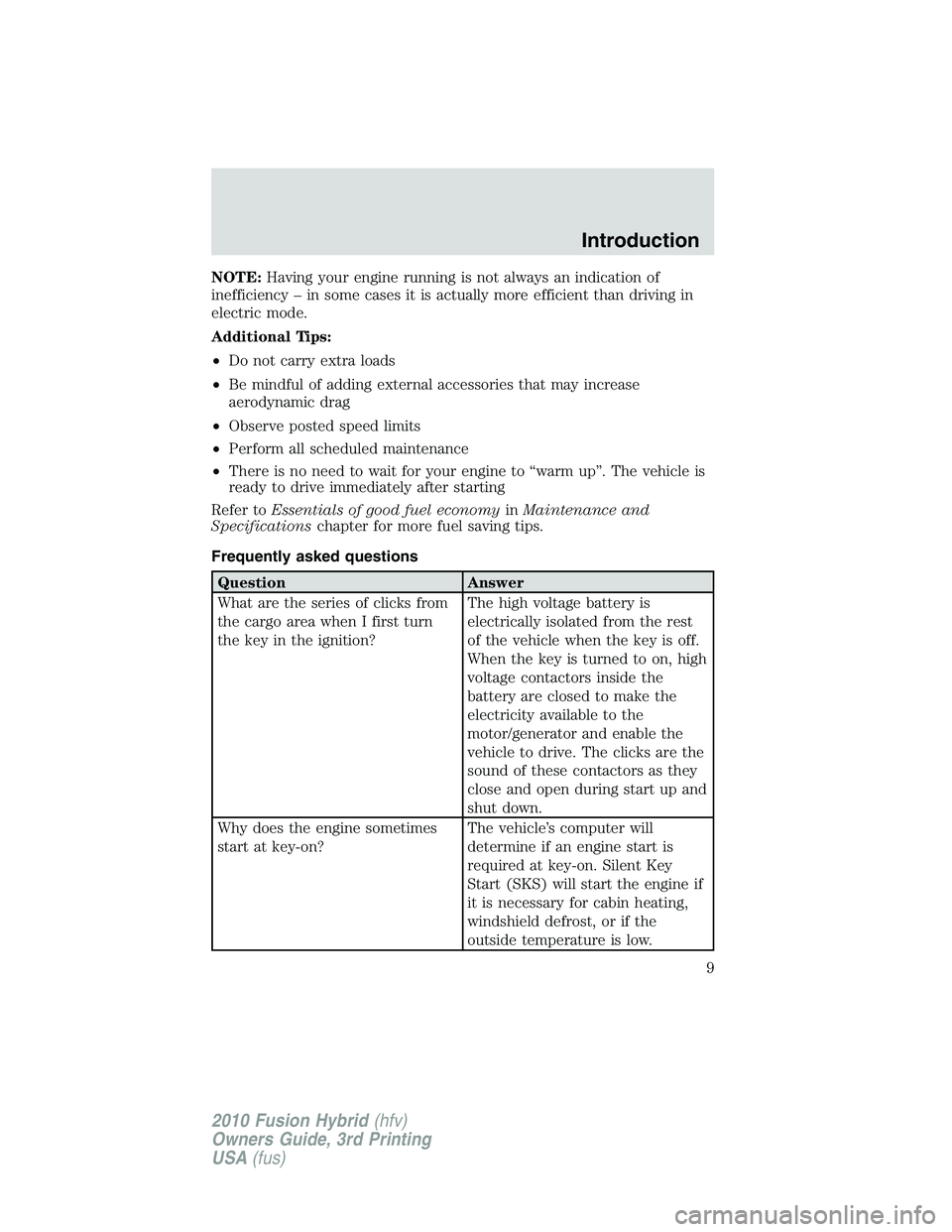
NOTE:Having your engine running is not always an indication of
inefficiency – in some cases it is actually more efficient than driving in
electric mode.
Additional Tips:
•Do not carry extra loads
•Be mindful of adding external accessories that may increase
aerodynamic drag
•Observe posted speed limits
•Perform all scheduled maintenance
•There is no need to wait for your engine to “warm up”. The vehicle is
ready to drive immediately after starting
Refer toEssentials of good fuel economyinMaintenance and
Specificationschapter for more fuel saving tips.
Frequently asked questions
Question Answer
What are the series of clicks from
the cargo area when I first turn
the key in the ignition?The high voltage battery is
electrically isolated from the rest
of the vehicle when the key is off.
When the key is turned to on, high
voltage contactors inside the
battery are closed to make the
electricity available to the
motor/generator and enable the
vehicle to drive. The clicks are the
sound of these contactors as they
close and open during start up and
shut down.
Why does the engine sometimes
start at key-on?The vehicle’s computer will
determine if an engine start is
required at key-on. Silent Key
Start (SKS) will start the engine if
it is necessary for cabin heating,
windshield defrost, or if the
outside temperature is low.
Introduction
9
2010 Fusion Hybrid(hfv)
Owners Guide, 3rd Printing
USA(fus)
Page 11 of 329
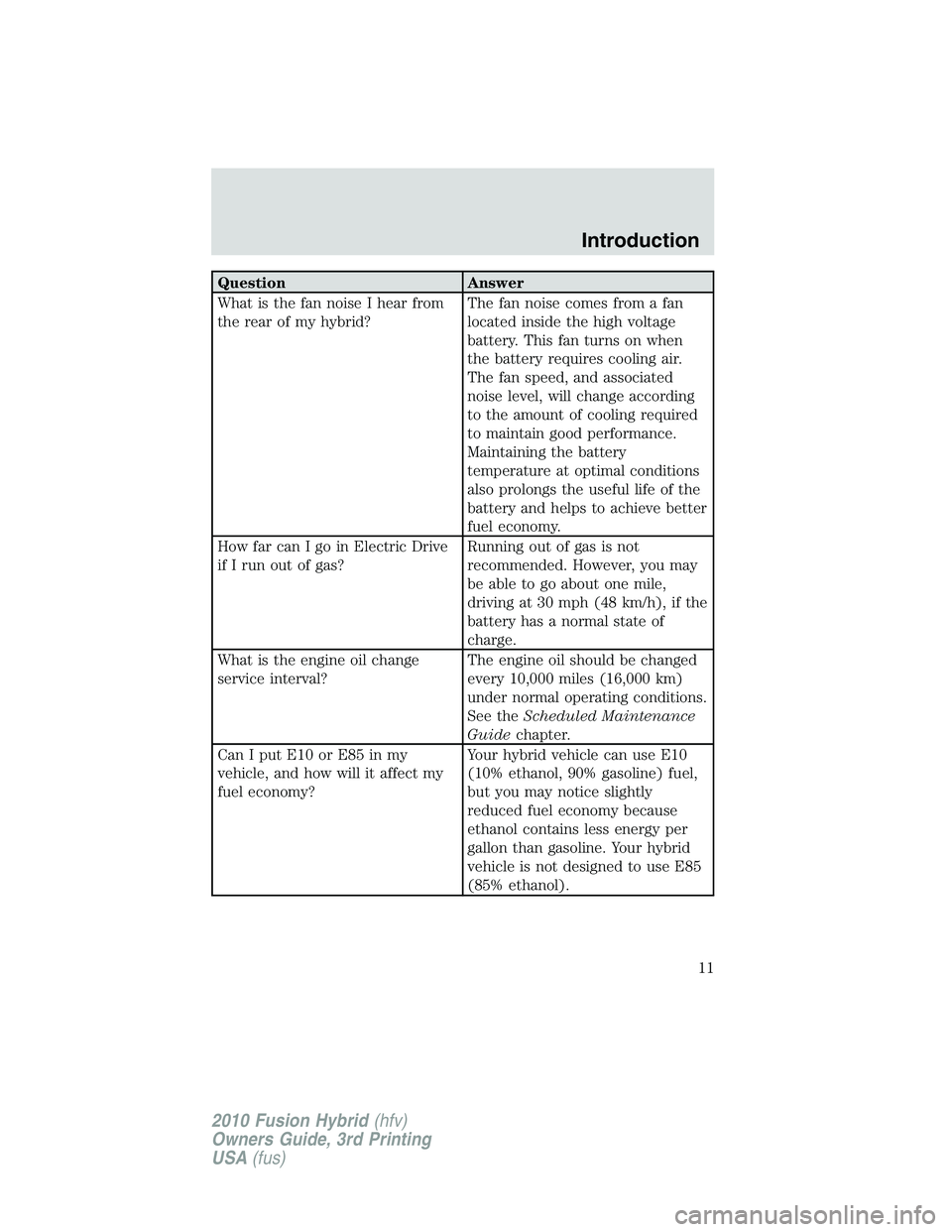
Question Answer
What is the fan noise I hear from
the rear of my hybrid?The fan noise comes from a fan
located inside the high voltage
battery. This fan turns on when
the battery requires cooling air.
The fan speed, and associated
noise level, will change according
to the amount of cooling required
to maintain good performance.
Maintaining the battery
temperature at optimal conditions
also prolongs the useful life of the
battery and helps to achieve better
fuel economy.
How far can I go in Electric Drive
if I run out of gas?Running out of gas is not
recommended. However, you may
be able to go about one mile,
driving at 30 mph (48 km/h), if the
battery has a normal state of
charge.
What is the engine oil change
service interval?The engine oil should be changed
every 10,000 miles (16,000 km)
under normal operating conditions.
See theScheduled Maintenance
Guidechapter.
Can I put E10 or E85 in my
vehicle, and how will it affect my
fuel economy?Your hybrid vehicle can use E10
(10% ethanol, 90% gasoline) fuel,
but you may notice slightly
reduced fuel economy because
ethanol contains less energy per
gallon than gasoline. Your hybrid
vehicle is not designed to use E85
(85% ethanol).
Introduction
11
2010 Fusion Hybrid(hfv)
Owners Guide, 3rd Printing
USA(fus)
Page 12 of 329
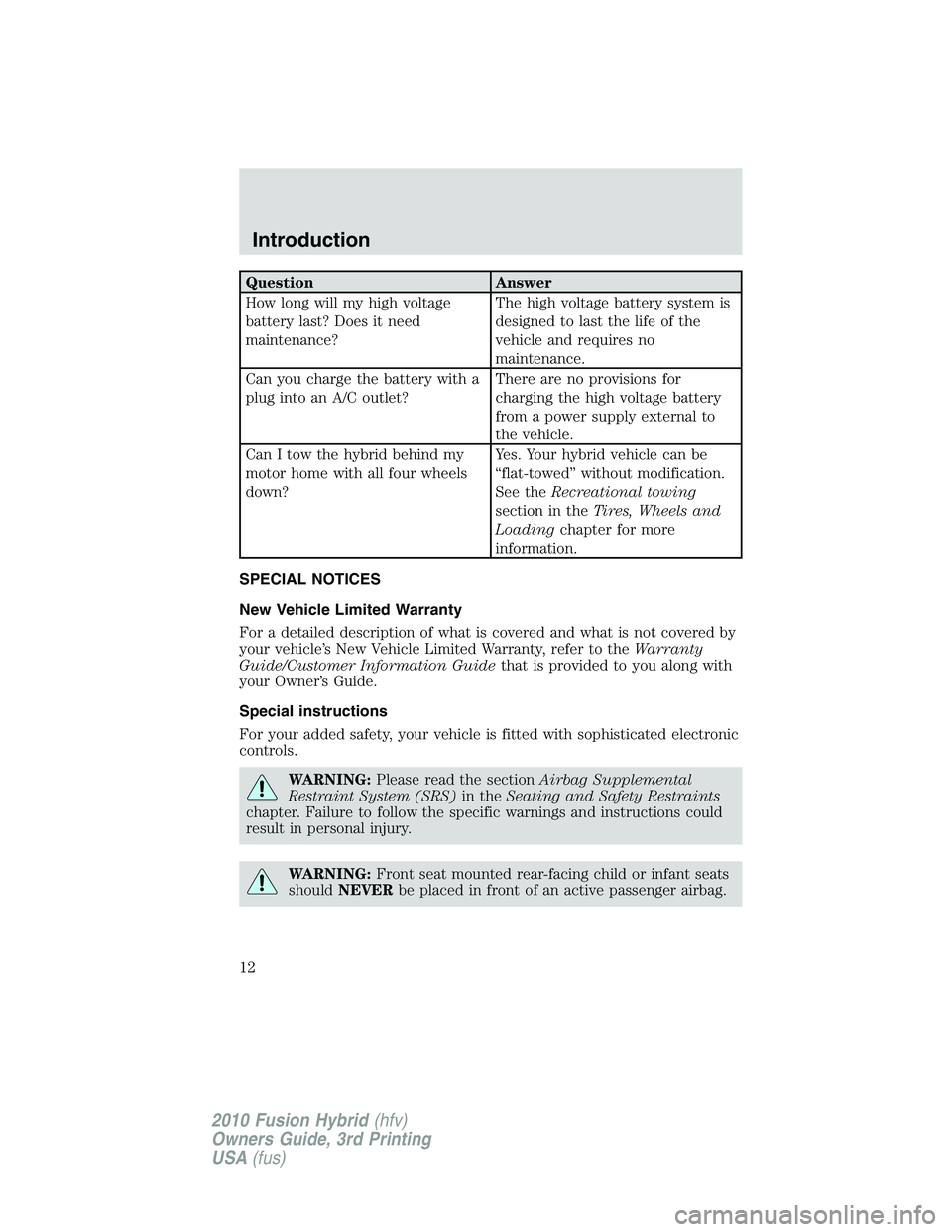
Question Answer
How long will my high voltage
battery last? Does it need
maintenance?The high voltage battery system is
designed to last the life of the
vehicle and requires no
maintenance.
Can you charge the battery with a
plug into an A/C outlet?There are no provisions for
charging the high voltage battery
from a power supply external to
the vehicle.
Can I tow the hybrid behind my
motor home with all four wheels
down?Yes. Your hybrid vehicle can be
“flat-towed” without modification.
See theRecreational towing
section in theTires, Wheels and
Loadingchapter for more
information.
SPECIAL NOTICES
New Vehicle Limited Warranty
For a detailed description of what is covered and what is not covered by
your vehicle’s New Vehicle Limited Warranty, refer to theWarranty
Guide/Customer Information Guidethat is provided to you along with
your Owner’s Guide.
Special instructions
For your added safety, your vehicle is fitted with sophisticated electronic
controls.
WARNING:Please read the sectionAirbag Supplemental
Restraint System (SRS)in theSeating and Safety Restraints
chapter. Failure to follow the specific warnings and instructions could
result in personal injury.
WARNING:Front seat mounted rear-facing child or infant seats
shouldNEVERbe placed in front of an active passenger airbag.
Introduction
12
2010 Fusion Hybrid(hfv)
Owners Guide, 3rd Printing
USA(fus)
Page 17 of 329

Vehicle Symbol Glossary
Power Windows
Front/Rear
Power Window Lockout
Child Safety Door
Lock/UnlockInterior Luggage
Compartment Release
Panic AlarmEngine Oil
Engine CoolantEngine Coolant
Temperature
Do Not Open When HotBattery
Avoid Smoking, Flames,
or SparksBattery Acid
Explosive GasFan Warning
Power Steering FluidMaintain Correct Fluid
LevelMAX
MIN
Service Engine SoonEngine Air Filter
Passenger Compartment
Air FilterJack
Check Fuel CapLow Tire Pressure
Warning
Introduction
17
2010 Fusion Hybrid(hfv)
Owners Guide, 3rd Printing
USA(fus)